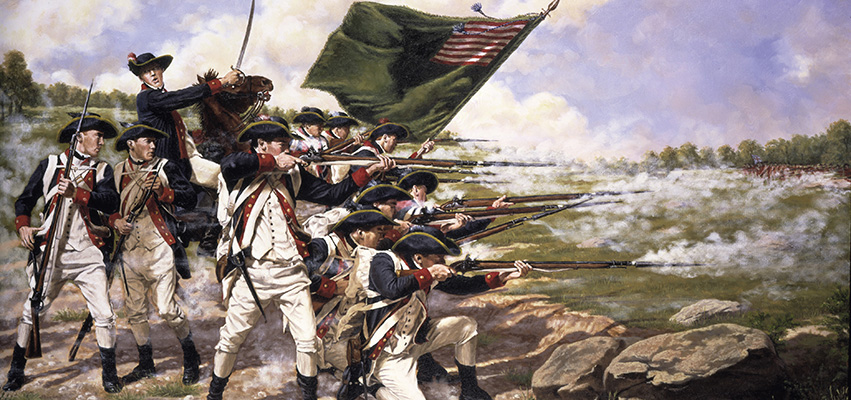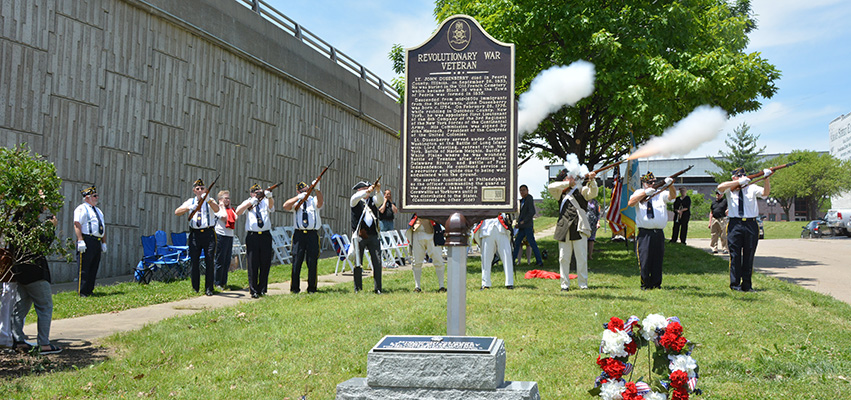
History of place is history of people, many of whom are unknown or forgotten. One such mystery of Peoria history was that of Lt. John Dusenberry—solved 186 years after his death. On Flag Day in 2019, a celebration of his life and service and dedication of memorials was conducted by the local chapters of the Daughters of the American Revolution and the Sons of the American Revolution. His was a distinguished life of patriotism, valor and selfless contribution, of which we are the beneficiaries through the liberties and freedoms we enjoy today as a nation. Though his time in Peoria was short, his legacy has endured.
Settling in America
John Dusenberry was a fourth-generation American, the great-grandson of Hendrick Hendricksen, born in 1630 in the Netherlands. The patriarch immigrated to New Netherland, on the east coast of what is now the United States, around 1650 during a time of great prosperity under Dutch Colonial Director General Peter Stuyvesant. Once here, Hendrick added “Von Doesburg” to his name, and this over time became “Dusenberry” and its variants. The family settled first in New Amsterdam (later renamed New York City), then lived on Long Island before moving up the Hudson River Valley.
It was from Dutchess County that John Dusenberry put into action his beliefs in freedom and self-determination. His father Moses was a colonel in the New York Militia, and he and his two brothers served in the Continental Army. Documents in the National Archives attest that all four distinguished themselves in their service. Moses Sr. lived to be 103 years old, while William lived to 100, Moses Jr. into his mid-80s, and John to 81. These were some tough Dutchmen.
John Dusenberry was born circa 1754 and enlisted in December 1775. Two months later, he was commissioned “First Lieutenant of the 8th Company of the 3rd Regiment of the New York Forces of the Continental Army”—a document signed by John Hancock himself, in his famously large script, as then-president of the Congress of the United Colonies.
Lt. Dusenberry’s first service assignment involved leading troops to “disarm persons disaffected to the liberties of the United Colonies,” which meant arresting British sympathizers. This local action was soon replaced with the most serious of military service assignments.
Continental Duties
On August 27, 1776, Lt. Dusenberry was under the command of the famous Lord Stirling at the Battle of Long Island, also known as the Battle of Brooklyn. It was the first major encounter of Washington’s Continental Army after the Declaration of Independence—and against overwhelming numbers of British forces. On that day Lt. Dusenberry likely heard firsthand the famous speech of his Commander-in-Chief, General George Washington:
“The time is now near at hand which must probably determine whether Americans are to be freemen or slaves. The fate of unborn millions will now depend, under God, on the courage and conduct of this army. Our cruel and unrelenting enemy leaves us only the choice of brave resistance or the most abject submission. We have, therefore, to resolve to conquer or die.”

Even in defeat and then trapped, the Continental Army escaped total annihilation by crossing from present-day Brooklyn into Manhattan—at night and through dense fog. If not for divine providence and tremendous acts of bravery, the Revolution might have been over right then and there. If so, we would today be drinking warm ale and speaking the queen’s English.
The following month, Lt. Dusenberry and his men fought the Retreat from Manhattan and then the Battle of Harlem Heights—more losses for the Continentals. In October at the Battle of White Plains, he was wounded in action and reported to have gone home “sick,” but soon returned to active duty. His next action came on December 26 at the famous Battle of Trenton—the Continental Forces’ first significant victory—as he was part of General Washington’s bold Christmas night crossing of the swollen and icy Delaware River.
In January 1777, Lt. Dusenberry saw action at the Battle of Fort Independence, his last battle duty, after which he continued his service as a recruiter, guide and brigade major, among other duties, to the end of the war. In 1782 he was in Philadelphia commanding the guard over the ordinance taken from General Cornwallis after the British surrender at Yorktown. He was discharged there in the spring of 1784.
Post-War in Peoria
After his discharge, it appears that Dusenberry stayed in Pennsylvania, married and started a family, with one son known to survive. In 1820, he was back in New York filing for his pension, attesting to his military service, his old age and infirmities, and inability to contribute to his support. He was given 500 acres of bounty land for his officer service, the sale of which likely funded his move to Peoria in 1832. When he, his son David, and grandson Moses Yoeman Dusenberry got here, there may have been as few as 10 permanent buildings in the city.
John Dusenberry’s probate and pension records indicate that he died in Peoria on September 26, 1833, just a year after his arrival. He was buried in the “Old French Cemetery,” which became “Block 35” when the Town of Peoria was formed, bounded by what are currently Adams, Harrison, Washington and Kumpf streets. Dusenberry’s grave markers are on the southwest corner of this early burying ground, which was used by Native Americans, French settlers, residents of Fort Clark and others before it was built over as the city rapidly developed. News articles spanning the course of a century mention the discovery of remains on that block.
John’s son David died in Peoria in 1843, and grandson Moses died here in 1908, a respected Peoria citizen. Several other members of the family are buried in Springdale Cemetery.
Veterans of Distinction
Today, grave markers for this Revolutionary War veteran appropriately stand on a street named Washington along the wall of a bridge named in honor of Robert H. (Bob) Michel, also a decorated veteran of distinction. Just as Lt. Dusenberry served in battles with long-remembered names, so did Bob Michel, a U.S. Army infantryman in World War II who participated in the invasion of Normandy and saw action in France, Belgium and Germany. He, too, was wounded in battle, for which he was awarded two Bronze Stars, the Purple Heart and four battle stars. I think Bob would approve of these fitting reminders in stone and metal to recognize Lt. John Dusenberry after all this time. Another forgotten mystery of Peoria history is now solved. PM
Bob Hoffer is a local history enthusiast and Caterpillar retiree who focuses on documenting and celebrating forgotten veterans. He is a member of the Peoria Historical Society and the Sons of the American Revolution.
- Log in to post comments

